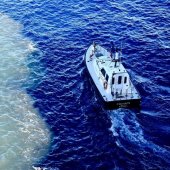
Laboratoire des sciences de l'environnement marin (LEMAR)
LEMAR is a resolutely interdisciplinary laboratory that brings together ecologists, biologists, microbiologists, biogeochemists, chemists, physicists and lawyers in the marine environment. Its objectives are: to conduct research on fundamental or socially important topics; to contribute to achieving sustainable development objectives in both northern and southern countries; to provide innovations in relation to the economic world and results in support of public policies; to engage in interdisciplinary training in the field of marine and coastal sciences.



